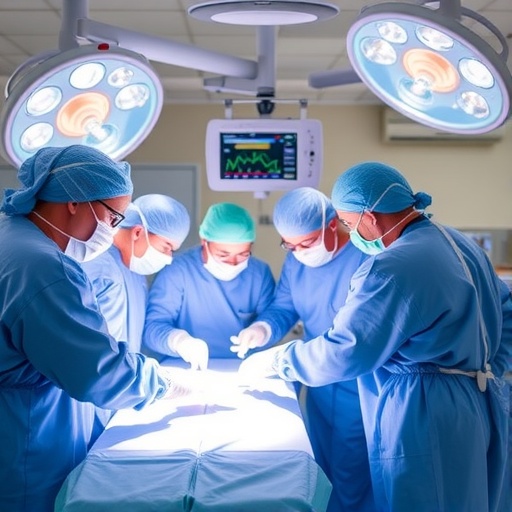In the rapidly evolving landscape of modern healthcare, the integration of technology has become an indispensable component of the operating room (OR). The arrival of new medical devices and digital tools has undoubtedly improved surgical outcomes, yet it has also raised significant concerns regarding safety and the efficient use of these technologies. In this regard, a recent research study led by a team of scholars, including D. Hacıdursunoğlu Erbaş, H. Azizoğlu, and B. Özdere, investigates the multifaceted relationship between technology utilization in surgical settings and associated factors that govern its safe implementation.
At the heart of this research is the understanding that while advanced surgical technologies—ranging from robotic systems to database management—play a critical role in patient safety, they also introduce new challenges. These challenges are not merely technical; they encompass human factors that can potentially disrupt the workflow in high-stakes environments like the OR. The authors of the study meticulously delve into how environmental, procedural, and psychological components influence the efficacy and safety of technology use in surgery.
One of the primary concerns in the operating room is the cognitive overload faced by surgical teams. As surgical teams incorporate numerous devices, they must simultaneously manage their usage along with the execution of complex procedures. This cognitive strain can lead to critical errors. The authors assert that healthcare professionals must adopt strategies for multitasking effectively to alleviate this pressure, ensuring that patient safety remains paramount. Furthermore, ongoing training and education are vital to prepare surgical teams for the intricacies of navigating sophisticated technology while maintaining focus on the operative task.
Another critical dimension explored in the study is the design and usability of surgical technologies. As innovations burgeon, the focus often shifts toward functionality rather than user experience. The authors highlight that if a device is cumbersome or its interface is not intuitive, it can contribute to operational mishaps. They advocate for a user-centric design approach, where feedback from surgical professionals informs the development of new technology. Such a collaborative process will not only enhance usability but ultimately improve patient safety in the OR.
The study also emphasizes the vital role of communication within the surgical team. Efficient collaboration and information sharing are crucial in environments where split-second decisions can greatly affect outcomes. The authors found that advances in technology such as real-time communication tools can facilitate better coordination among team members. By establishing clear lines of communication and employing technological aids, surgical teams can streamline operations and minimize the risk of errors during procedures.
Moreover, the deployment of technologies must be accompanied by strict adherence to protocols and safety guidelines. The research highlights various instances where the failure to follow established procedures led to disastrous outcomes. The authors call for the surgical community to rigorously uphold standards of practice, reinforcing the notion that technology should not supplant fundamental safety guidelines but rather enhance them. Implementing comprehensive checklists and standardized operating procedures can safeguard against human error, integrated responsibly with technological advancements.
A particularly fascinating portion of the research acknowledges the psychological aspects of technology implementation in surgical settings. The notion of ‘technological anxiety’ emerges, where medical personnel may feel overwhelmed or fearful of new innovations. This anxiety can hinder the acceptance and effective use of new tools, consequently undermining potential improvements in surgical outcomes. The authors argue that fostering a culture of openness and continuous learning will mitigate such anxieties, enabling professionals to embrace the advancements that technology offers.
In addition to these components, the study looks at the impact of staffing levels and team dynamics on technology utilization in the OR. Fresh data indicates a correlation between the presence of skilled personnel and the successful integration of advanced devices. In scenarios where teams are understaffed or lack certain skills, the risk of complications rises. The authors draw attention to the importance of adequate training and professional development opportunities that align with technological advancements to ensure that every team member is equipped to perform safely and effectively.
Importantly, the article extends its scope to encompass a broader perspective on patient involvement in the technological dimensions of surgical care. Patients are increasingly becoming part of the conversation regarding the use of technology. They often inquire about the surgical methods employed and the tools used in their procedures. The authors encourage transparency in this dialogue, suggesting that informed patients tend to have a reduced sense of anxiety and a greater understanding of their care. This patient engagement catalyzes a more supportive environment conducive to fostering trust in surgical teams and their technological capabilities.
The authors conclude their research with recommendations for healthcare institutions looking to enhance their operational protocols. They suggest conducting regular assessments of technology use in surgical settings, emphasizing the necessity for ongoing evaluation of how these innovations affect surgical outcomes. By collecting data and reviewing procedures, healthcare professionals can identify gaps in safety practices, thus driving continuous improvement.
As the healthcare landscape continues to evolve, it is imperative to prioritize safe technology use in surgical environments. The study by Erbaş, Azizoğlu, and Özdere serves as a clarion call for the medical community not only to embrace technological innovations but to do so with a keen eye on safety, effectiveness, and the overall quality of care. It highlights the importance of a multi-faceted approach that combines technology with human elements to achieve a balanced and efficient surgical process, ultimately benefiting both healthcare providers and patients alike.
In conclusion, the critical inquiries posed in this research underscore the necessity of thoughtful integration of technology in surgical practice. The authors leave us with the understanding that as we traverse this digital frontier, the key lies in balancing state-of-the-art advancements with a steadfast commitment to patient safety. The journey ahead will require collaboration, education, and constant evolution as we forge a new path for operating rooms worldwide.
Subject of Research: Safe technology use in the operating room and related factors
Article Title: Safe technology use in the operating room and related factors
Article References:
Hacıdursunoğlu Erbaş, D., Azizoğlu, H., Özdere, B. et al. Safe technology use in the operating room and related factors.
BMC Health Serv Res (2025). https://doi.org/10.1186/s12913-025-13805-3
Image Credits: AI Generated
DOI: 10.1186/s12913-025-13805-3
Keywords: technology in surgery, patient safety, surgical team dynamics, cognitive overload, user experience, communication in OR, technological anxiety, training and education, healthcare innovations.
Tags: advanced medical devices in operating roomscognitive overload in surgical teamsefficient use of technology in healthcareenvironmental factors affecting surgeryhuman factors in operating room technologyimpact of digital tools on surgerypatient safety in surgical environmentspsychological components in surgical proceduresresearch on surgical technology safetysafe use of technology in operating roomssurgical technology integration challengesworkflow management in surgical settings





